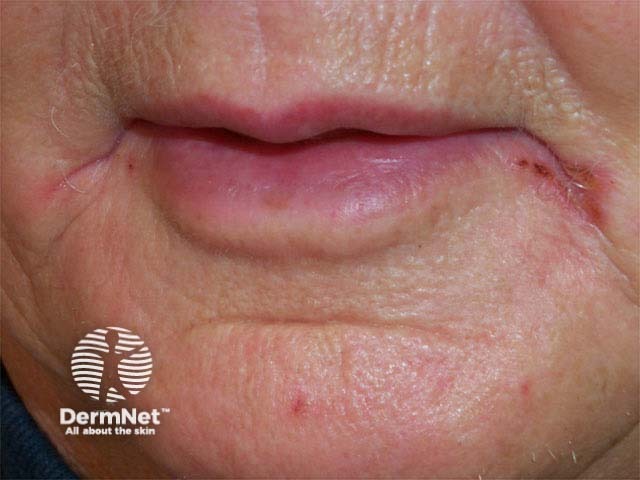Main menu
Common skin conditions

NEWS
Join DermNet PRO
Read more
Quick links
For each of the ten cases, study the image(s) and then answer the questions. You can click on the image to view a larger version if required.
Each case should take approximately five minutes to complete. There is a list of suggested further reading material at the end of the quiz.
When you finish the quiz, you can download a certificate.

What is the aetiology?
Angular cheilitis (perlèche) is an acute or chronic inflammation of the angles of the mouth resulting in erythema, soreness and fissuring. Its aetiology is often mixed: mechanical factors. In the edentulous or elderly, the upper lip overhangs the lower lip resulting in maceration; dribbling or licking results in an irritant dermatitis; symptomatic cheilitis is infected with Staphylococcus aureus (80%), Candida (40%) and/or beta haemolytic streptococci (15%); ot is more common if the skin is dry as in atopic or seborrhoeic dermatitis; dry mouth due to Sjogren's syndrome or drugs predisposes to Candida; dry lips due to mouth breathing or drugs (isotretinoin) predispose to Staphylococcal infection; consider nutritional deficiency, especially lack of iron, zinc, B vitamins and/or protein.
What investigations are appropriate?
Evaluate the patient for underlying causes and investigate if clinically indicated or if the cause of the cheilitis is not apparent. Look for candida in the patient's oral mucosa and dentures, and for Staph. infection elsewhere.
How would you treat this?
Initial treatment might be with a mixed mild topical steroid/antifungal/antibiotic such as Pimafucort or Kenacomb cream, applied two or three times daily for up to two weeks. If present, oral candidiasis should be treated. Apply antibiotic ointment too nasal carrier sites if the cheilitis is staphylococcal. Advise the patient not to lick the affected area. Apply lip salve to dry lips. Angular cheilitis can be difficult to clear in the elderly because of the overhanging upper lip. Suggest dental review to increase the vertical dimension of the bite. In some patients dermal augmentation with collagen or hyaluronic acid implants might be helpful.
Finished!
If you would like to receive a certificate of participation please enter your name below and click Download.